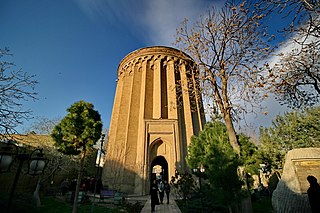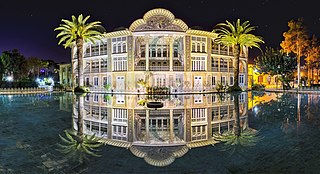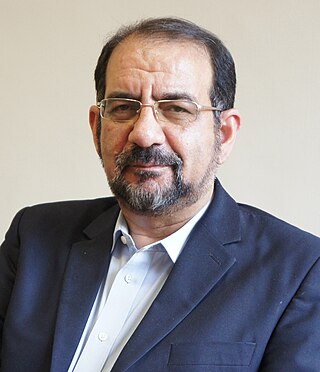
Toghrol Tower is a 12th-century monument, located in the city of Rey, Iran. Tuğrul Tower is near Rashkan Castle.

Eram Garden is a historic Persian garden in Shiraz, Iran. The garden, and the building within it, are located at the northern shore of the Khoshk River in the Fars province.

Iran national under-23 football team, also known as Iran U-23 or Iran Olympic Team; represents Iran in international football competitions in Olympic Games, Asian Games and AFC U-22 Asian Cup, as well as any other under-23 international football tournaments. It is controlled by the Iran Football Federation.
In the US, paramedicine is the physician-directed practice of medicine, often viewed as the intersection of health care, public health, and public safety. While discussed for many years, the concept of paramedicine was first formally described in the EMS Agenda for the Future. Paramedicine represents an expansion of the traditional notion of emergency medical services as simply an emergency response system. Paramedicine is the totality of the roles and responsibilities of individuals trained and credentialed as EMS practitioners. These practitioners have been referred to as various levels of Emergency Medical Technician (EMTs). In the United States paramedics represent the highest practitioner level in this domain. Additional practitioner levels in this domain within the U.S. include Emergency Medical Responders (EMRs), Emergency Medical Technicians (EMTs) and Advanced Emergency Medical Technicians (AEMTs).
Daadshah is a 1983 Iranian Persian-language film depicting the life and experiences of Baloch rebel Dad Shah in the Balochistan insurgency.
Museum of Ostad Bohtouni is a museum in Tabriz, north-western Iran. The museum is located in the Sheshghelan suburb of Tabriz.
Mohammad Sadri is an Iranian film director, writer, film producer and cinematographer.
Grady straps are a specific strapping configuration used in full body spinal immobilization.
Emergency medical services in Iceland include the provision of ambulance service. They provide all emergency ambulance service for a population of in excess of 320,000 people in one of the most sparsely settled countries in Europe. The system is government-funded for the first 85 percent of cost, with 15 percent being charged to the individual as a deterrent fee. All services in Iceland are provided by the Icelandic Red Cross, with individual ambulances often co-located with local fire brigades.
Armenian Sports Club was an Iranian football club based in Tehran, Iran. It was Iran's first sport club for Iranian-Armenians. It is not known exactly when the sport club ceased to exist, but it can be assumed that it was sometime in the 1930s as, in 1944, Ararat Tehran was established and became the sport club for Iranian-Armenians.

The Iran Taekwondo Association "I.T.A" is the First N.G.O & Non-governmental Federation of Iran sport which started its activities with the official authority of Iran's Interior Ministry and Justice Ministry in 2001.

Gholam-hossein Ebrahimi Dinani is an Iranian philosopher. He is best known for his research and writings about illuminationism and Shahab al-Din Suhrawardi. The three-time winner of Book of the Year award in Iran, Dinani is a professor emeritus at the University of Tehran, and lectures at Tarbiat Modares University and Ferdowsi University of Mashhad. Moreover, his public lectures at Institute for Research in Philosophy attract a diverse audience from students and scholars of theology and philosophy in general.

Ahmad Khatami is a professor of Persian language and literature, a lecturer at the Department of Persian Language and Literature, and the head of the Center of Excellence of Persian Literary History at Shahid Beheshti University in Iran.
Firuzabad or Firozabad is a village in Sajjadrud Rural District, Bandpey-ye Sharqi District, Babol County, Mazandaran Province, Iran. At the 2006 census, its population was 439, in 112 families. Its appellation is derived from residents of that tribe is Firouzjai.

The Border Guard Command, commonly known as FARAJA Border Guard, is a subdivision of the Law Enforcement Force (FARAJA) and Iran's sole agency that performs border guard and border control duties for land borders, and coast guard duties for maritime borders. The unit was founded in 2000. Between 1991 and 2000, border control was the responsibility of the Security deputy of FARAJA. Prior to 1991, border control was the responsibility of the Gendarmerie.
31st Ashura Division was a division of the Islamic Revolutionary Guard Corps. It covers the provinces of East Azarbaijan, West Azarbaijan, and Ardabil.
Operation Dawn-10 or Walfajr-10 was a large scale offensive operation launched during the Iran–Iraq War by Iran against Iraq on March 15, 1988 near the final stages of the war's conclusion. It was commanded by the Pasdaran along with the participation of some regular army forces as support. During Operation Dawn-10, Iran changed its operational area from southern to northern Iraq. The operation was started with the code of "Ya Rasūl Allāh (s)" (Persian: (یا رسول الله, and performed in 5 phases.

Hamidreza Khankeh is an Iranian scientist in the field of Emergency and Disaster Health and former chancellor of the University of Social Welfare and Rehabilitation Sciences. He became known for his development of national guidelines to prepare hospitals against disasters, National Respond Framework in disasters and the integration emergency numbers in Iran. He has been a member Academy of Medical Science Iran since 2016... Khankeh has been head of department and research center of Health in Emergency and Disaster in University of Social Welfare and Rehabilitation Science Tehran since 2012. From 2017 he has held vice chancellor for National Emergency Medical Organization of Iran, national advisor for deputy of nursing in Ministry of Health in emergency and disaster and also advisor of National Disaster Management Organization and Tehran Disaster Mitigation and Management Organization (TDMMO)

FAKHRAVAC is a COVID-19 vaccine developed in Iran by the Organization of Defensive Innovation and Research, a subsidiary of Iran's Ministry of Defense. It is the third Iranian COVID-19 vaccine reaching clinical trials. It is currently in phase III. It has received emergency use authorization in Iran on 9 September 2021.
The National Organization for Passive Defense is an Iranian government bureau for civil defense. It was approved in August 2023. It will arm and defend the infrastructure from biologic, cyber, nuclear, electronic, chemical warfare and the CBRNE threat.








